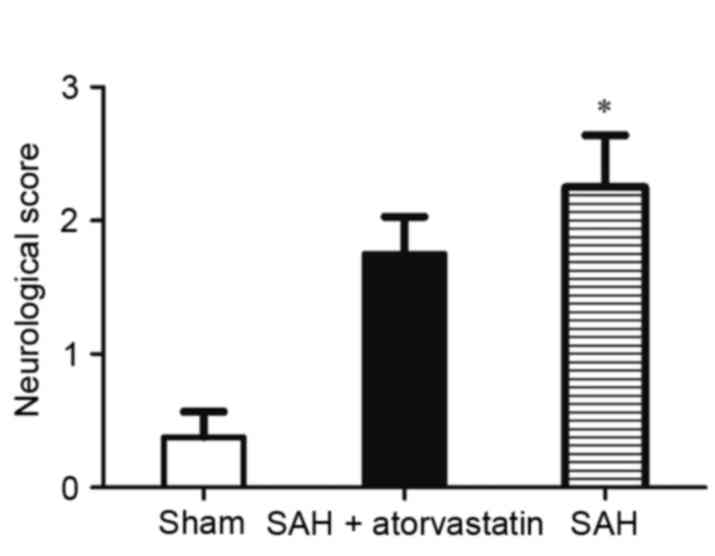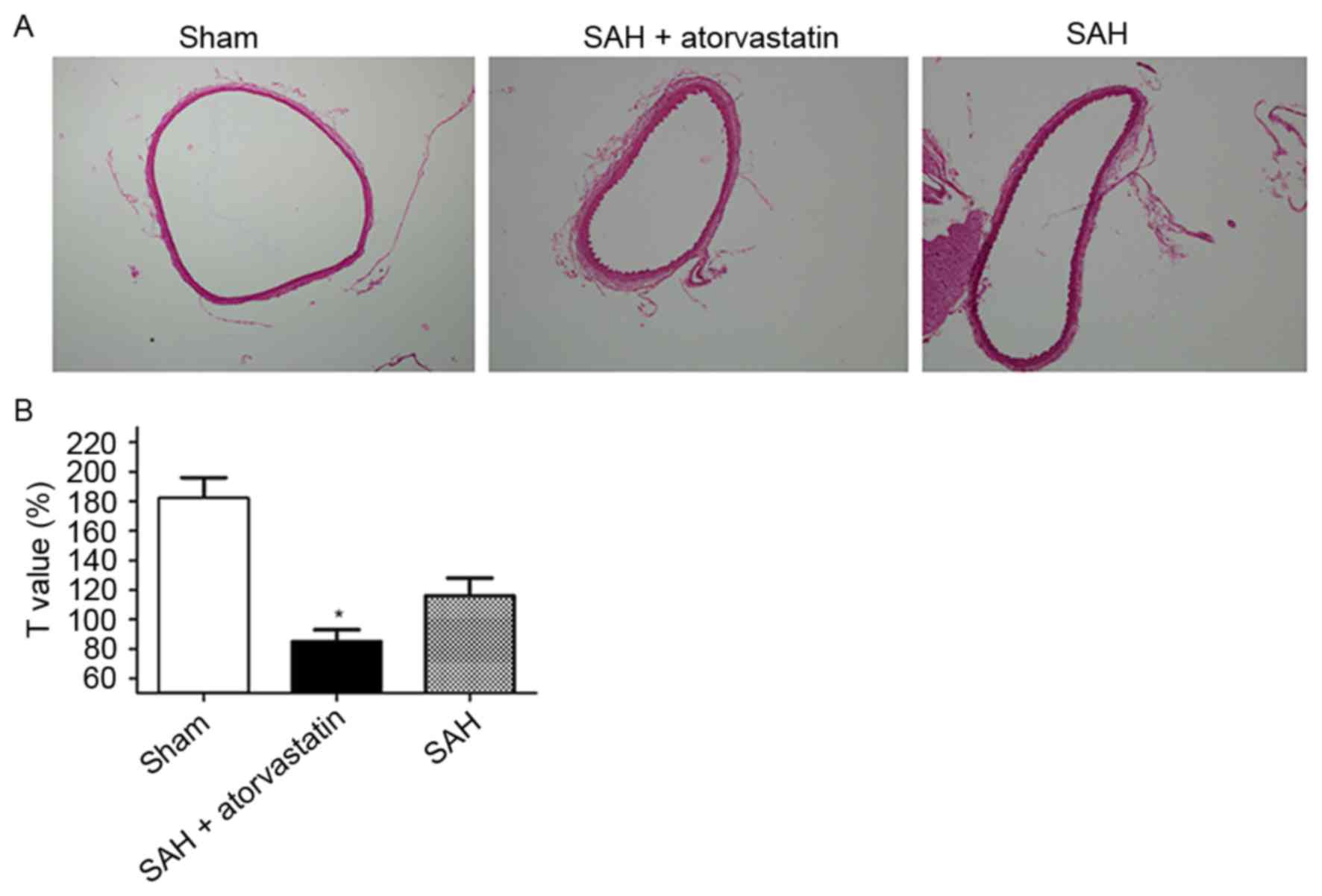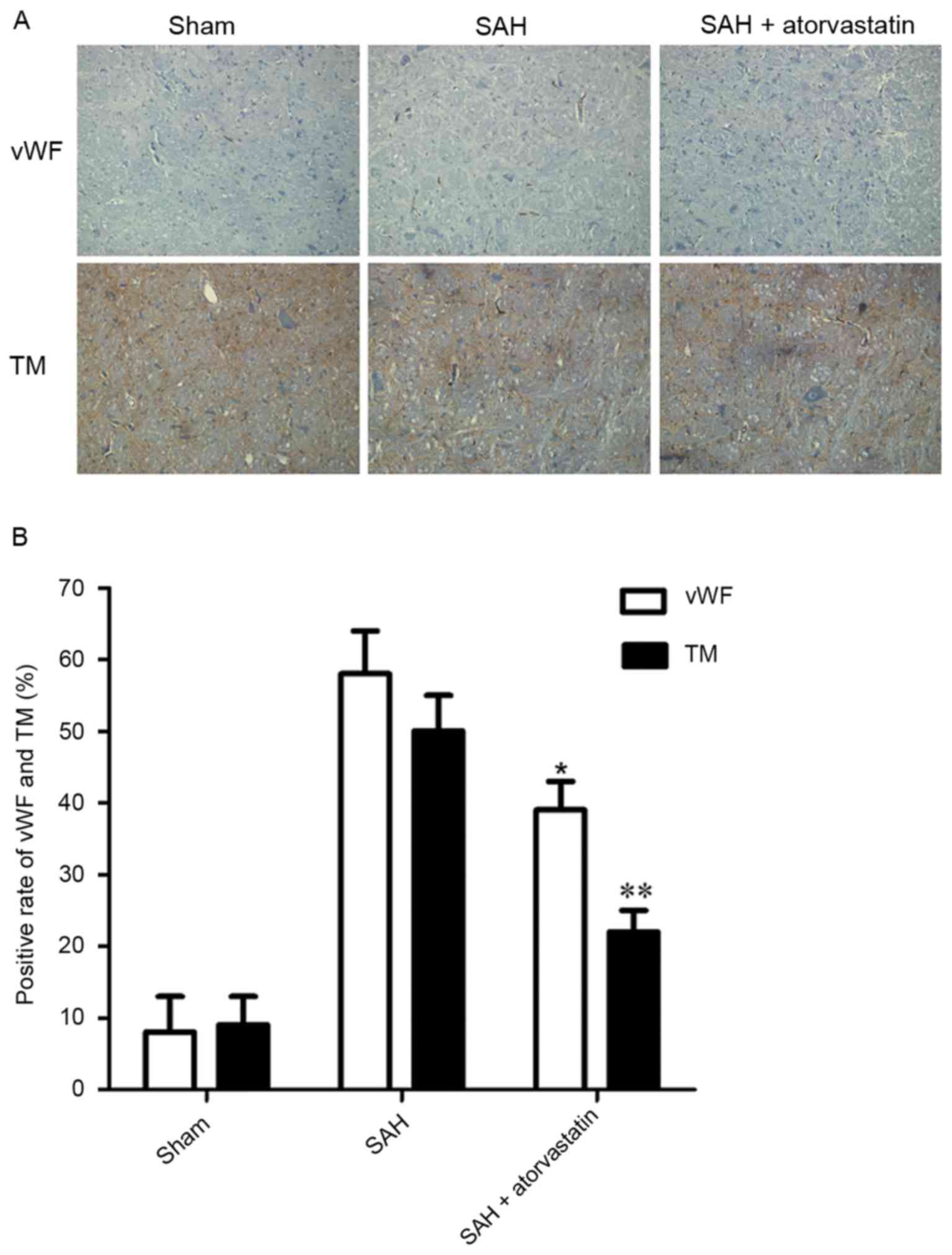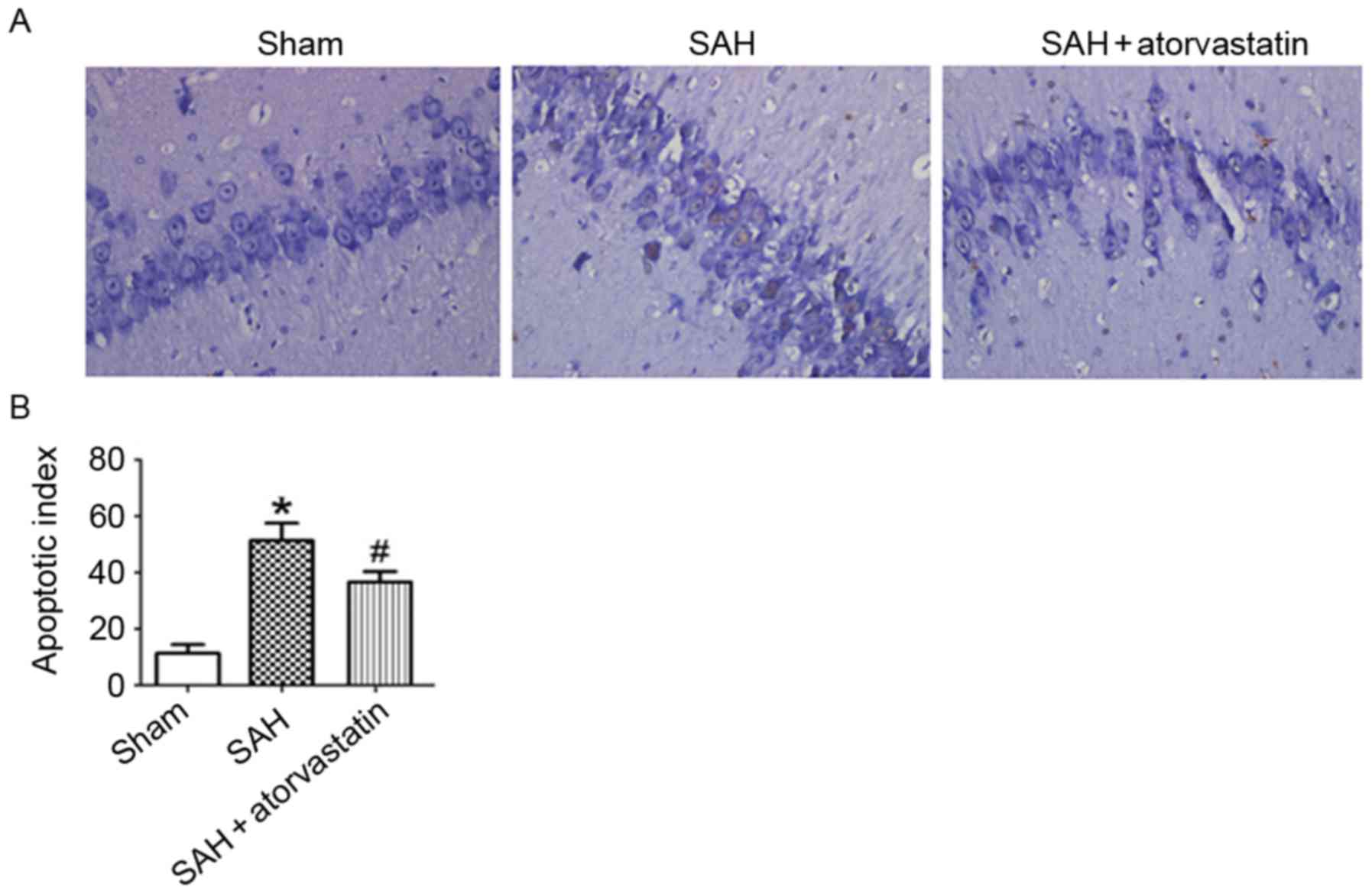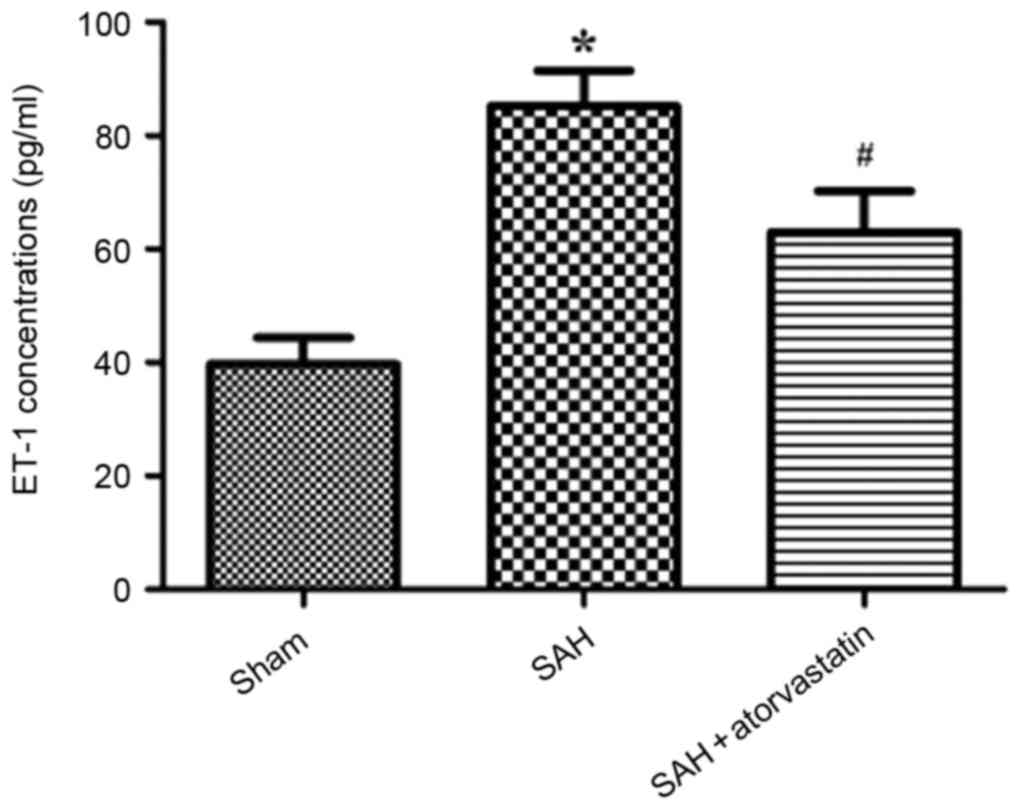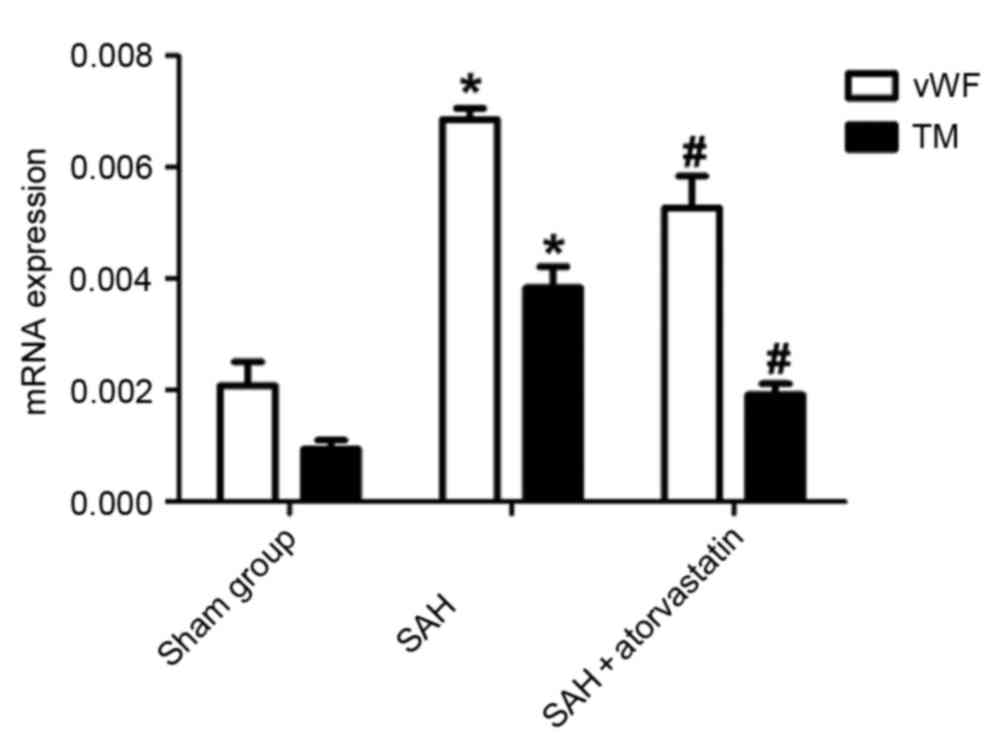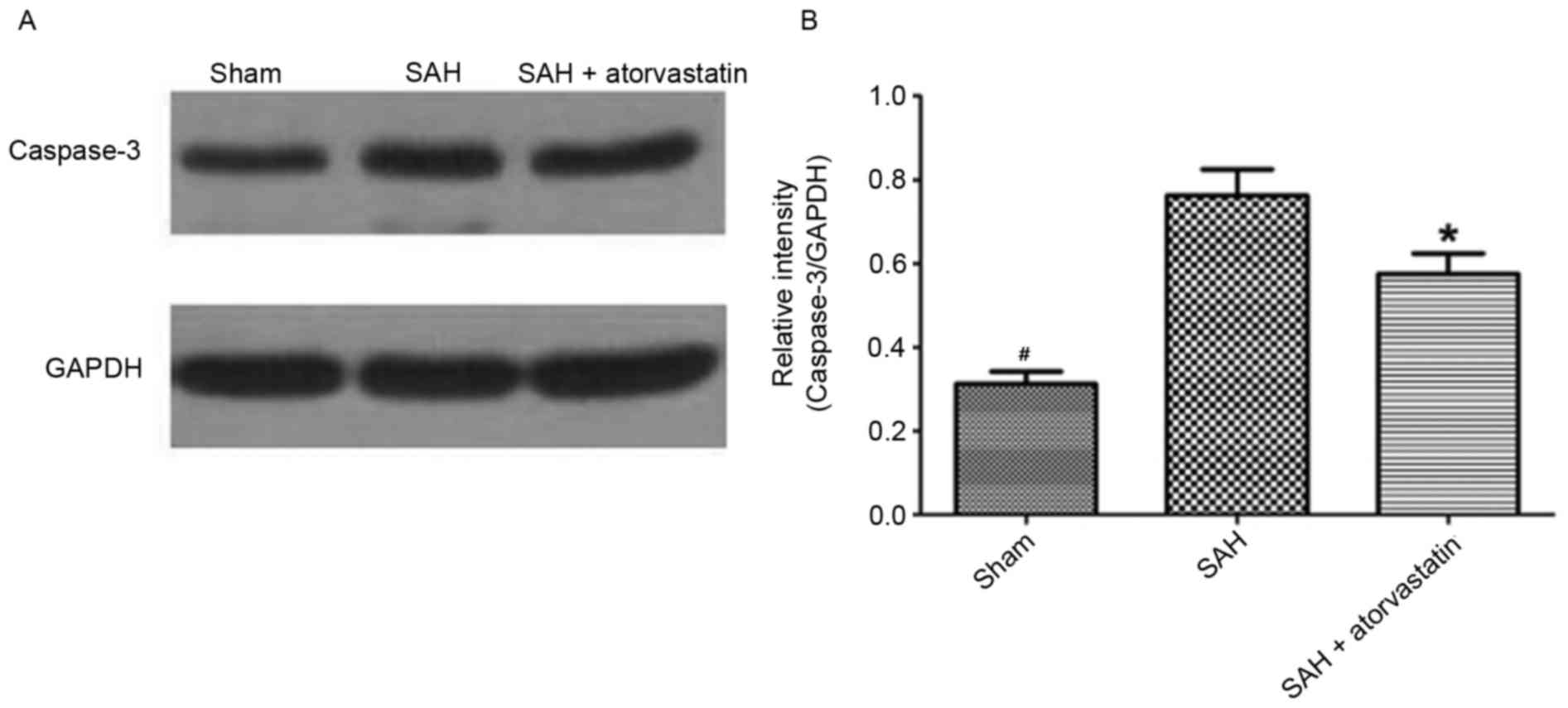Protective effects of atorvastatin on cerebral vessel autoregulation in an experimental rabbit model of subarachnoid hemorrhage
- Authors:
- Published online on: November 15, 2017 https://doi.org/10.3892/mmr.2017.8074
- Pages: 1651-1659
-
Copyright: © Chen et al. This is an open access article distributed under the terms of Creative Commons Attribution License.
Abstract
Introduction
Spontaneous subarachnoid hemorrhage (SAH) is a common cerebral vascular condition that affects 9 out of 100,000 people in the Western world (1,2). Although it accounts for ~5% of all strokes, it is a devastating neurological condition with poor outcomes and high mortality and morbidity (1–3). Early brain injury (EBI), acute hydrocephalus, delayed cerebral vasospasm (CVS) and cerebral infarction are important factors that may contribute to poor outcome post-SAH. However, data from a previous study indicated that treatment of CVS, using targeted medication in patients with SAH, may not lead to improved neurological outcomes, and suggested that CVS may not be the only cause of the delayed ischemic complications (4). Additional studies reported that the functional outcome did not improved with reversal of angiographic vasospasm (5), and that treatment with an endothelin receptor antagonist may significantly improve CVS post-SAH (6), but it did not improve the poor outcome.
Cerebral vessel autoregulation is the intrinsic ability of the cerebral vasculature to maintain stable blood flow even during changes in blood pressure, such as cerebral perfusion pressure (7). A recent review of the clinical effects of disturbed cerebral vessel autoregulation following aneurysmal SAH aimed to determine whether patients with SAH may benefit from therapeutic targeting of cerebral vessel autoregulation (4). However, large-scale analyses are required to determine clinical benefits, and it was suggested that statins may serve an important role in cerebral vessel autoregulation.
Statins, which are inhibitors of the 3-hydroxy-3-methylglutaryl-coenzyme A (HMG-CoA) reductase, are widely used in cardiovascular therapy as cholesterol-lowering drugs that may have pleiotropic effects, including anti-inflammatory (8), antioxidative stress (9), anti-CVS (10,11) and inhibition of platelet aggregation (12,13). Atorvastatin is a potent statin that inhibits HMG-CoA reductase; however, the specific pathophysiological mechanisms of statins on cerebral vessel autoregulation and EBI following SAH remain unknown. Therefore, the aim of the present study was to evaluate the effects of atorvastatin on SAH-induced EBI, CVS and function of vascular endothelial cells. Results revealed that atorvastatin was an effective and well-tolerated treatment for SAH in various clinical settings and may protect the autoregulation of cerebral vessels. The present study investigated whether clinical benefits could be achieved by influencing the state of cerebral vessels autoregulation.
Materials and methods
Animals and drugs
Animal's care and experimental protocols were approved by the Animal Care and Use Committee of Anhui Medical University (Hefei, China) and conformed to the Guide for the Care and Use of Laboratory Animals as outlined by the National Institutes of Health. New Zealand white rabbits used in the present study were purchased from Animal Central of TaiHu Hospital (cat. no. SYXK2012-0033; Wuxi, China). Rabbits were raised in a comfortable room with normal atmospheric moisture and fed with a standard diet every 3–4 h at the Animal Center of Taihu Hospital for 10 days prior to the start of the experiments. The temperature of the feeding and operation rooms was maintained at 22°C. Atorvastatin (20 mg/kg/d; Pfizer, Inc., Wuxi, China) was administered by gastric gavage once daily for 3 days prior to SAH operation and 22 h post-SAH to maintain drug levels (14). Neurological deficits were assessed 24 h following SAH operation and rabbits were euthanized immediately following evaluation. The data of blood pressure, injected arterial blood gas data, body weight and blood pressure were used for monitoring only, and were not shown in the results of the present study.
Experimental design
A total of 48 adult male New Zealand white rabbits (weight, 2.5–3.2 kg) were randomly assigned to 3 groups (n=16/group): i) Sham group, which received an injection of saline into the cisterna magna (2 ml); ii) SAH group; and iii) SAH + atorvastatin group. As 3 rabbits died in the SAH group and 4 rabbits died in the SAH + atorvastatin group, 3 additional rabbits were added for the SAH group and 4 additional rabbits were added for the SAH + atorvastatin group. Atorvastatin (20 mg/kg/d) was administered when the SAH model was established and continued every 24 for 72 h, as previously described (10). A total of 8 rabbits from each group were sacrificed on day 3 with the fixation-perfusion method in 10% formaldehyde. The hippocampus and basilar artery (BA) were removed for terminal deoxynucleotidyl-transferase-mediated dUTP nick-end labeling (TUNEL), hematoxylin and eosin (H&E) and for immunohistochemical staining analyses. The remaining eight rabbits were exsanguinated and decollated, and the artery was removed and frozen in deep cryogenic freezer for further biochemical studies. Prior to sacrifice, serum samples were collected from each rabbit to evaluate the protein expression levels of endothelin-1 (ET-1) by ELISA.
SAH model rabbit establishment
SAH was induced according to a previously described two-hemorrhage rabbit model (10,14). Briefly, rabbits were anesthetized with an auricular marginal vein injection of 10% chloral hydrate (2.5 ml/kg). Vital signs were kept stable and a 23-gauge butterfly needle was inserted into the cisterna magna. When cerebrospinal fluid was observed from the butterfly needle, then 2 ml non-heparinized fresh autologous auricular arteries blood was injected into the cisterna magna from the butterfly needle with strict aseptic technique and the injection lasted 1 min. To maintain the blood flow from cisterna magna to the basilar cistern, all rabbits were held at a 30-degree head-down position for 30 min. Rabbits were returned to the feeding room following recovery from anesthesia. The second injection was administered after 48 h in a similar manner.
Neurological scoring
Neurological scores were recorded by the same independent observer who was blinded to the study. A previously modified scoring table was used to evaluate the neurological function every day (14,15). The Neurological study consisted of the following three tests: i) Appetite. Scores indicate the following: 2, Scarcely ate; 1, left meal unfinished; 0, finished meal. ii) Activity. Scores indicate the following: 2, Almost always lying down; 1, lying down, will stand and walk with some stimulation; 0, active, alert or standing. iii) Deficits. Scores indicate the following: 2, Impossible to walk and stand due to ataxia and paresis; 1, unable walk due to ataxia or paresis; 0, no deficits.
Fixation-perfusion
A total of 8 rabbits from each group were anesthetized with an auricular marginal vein injection of 10% chloral hydrate (4 ml/kg). The chest was quickly cut open for cannula intubation in the left ventricle and the right atrium was cut open. Perfusion started with 1,500 ml of physiological phosphate buffered saline (PBS; pH 7.3) at 37°C, followed by 1,000 ml buffered formaldehyde (10%) under 120 cm H2O perfusion pressure. Following fixation-perfusion, whole brain tissues were removed and stored in 10% formalin at 22°C.
H&E staining
This tissue was then post-fixed in 4% paraformaldehyde at 4°C overnight, dehydrated and embedded in paraffin, and cut into sections (4 µm). To avoid the arterial branches, the BAs were transected at the same middle position each time (2 mm). Every fourth section along the coronal plane was stained with H&E and observed under a microscope. The diameter, perimeter and cross-sectional area of the BA were measured by an independent investigator, blinded to the study, using an Olympus light microscope (Olympus Corporation, Tokyo, Japan) and Image-Pro Plus 6.0 Software (Media Cybernetics, Inc., Rockville, MD, USA). The diameter, perimeter and cross-sectional area of BA were calculated as previously described (16). T-score indicates the BA perimeter/BA thickness.
Immunohistochemical staining
Brain tissues (brainstem) were isolated from brain tissues before storing in formalin, and were routinely fixed, embedded and cut into sections (4 µm) for immunohistochemistry. Endogenous peroxidase was quenched with 3% hydrogen peroxide for 10 min at room temperature. Sections were incubated with anti-von Willebrand factor (vWF; cat no. ab778; dilution 1:30; Abcam, Cambridge, UK) and anti-thrombomodulin (TM; cat no. ab6980; 1:1,000; Abcam) primary antibodies overnight at 4°C, followed by incubation with HRP-conjugated secondary antibodies (goat serum; cat no. ab138478; Abcam) for 1 h at room temperature. Following washing, sections were developed in 3,3′-diaminobenzidine (DAB) solution and counterstained with hematoxylin for 5 min at room temperature. Negative controls were included by omitting the primary antibody. A light Olympus microscope (Olympus Corporation) and Image-Pro Plus 6.0 software (Media Cybernetics, Inc.) were used for analysis.
TUNEL staining and cell counting
The TUNEL Staining kit (Roche Diagnostics, Basel, Switzerland) was used for hippocampus staining, and the TUNEL-positive cells were analyzed by fluorescein-dUTP with dNTP or POD with DAB (manufacturer's protocol for in situ apoptosis detection kit (Roche Diagnostics) according to the methods described previously (17). A negative control was used by eliminating the TUNEL reaction mixture. Cells exhibiting nuclear condensation/fragmentation and apoptotic bodies in the absence of cytoplasmic TUNEL reactivity, brown staining of nuclei were considered as apoptotic cells. Apoptotic cells were confirmed with the help of a pathologist blinded to the grouping. The number of TUNEL-positive cells in each region (number/mm2) were counted in a high-powered field (magnification, ×400) by an investigator who was blinded to the study. A total of 8 rabbits from each group were used. A total of 5 fields were analyzed, and the experiment was repeated three times.
Western blot analysis
Western blot analysis was performed as described previously for evaluating the levels of Caspase-3 proteins (18). The samples (20 µg protein), as determined by using a bicinchoninic acid assay (Abcam), were separated by 10% SDS-PAGE and transferred to a nitrocellulose membrane. Membranes were probed with the following primary antibodies: Rabbit anti-Caspase-3 (cat no. ab4051; 1:500; Abcam) antibody. GAPDH (cat no. G5262; 1:6,000; Sigma-Aldrich; Merck KGaA, Darmstadt, Germany) was used as a loading control. Following incubation with the primary antibodies for 1 h at room temperature, membranes were washed with TBS + 5% Tween-20 (TBST) and incubated with appropriate horseradish peroxidase-labeled secondary antibodies (cat no. sc2357; 1:1,000; Santa Cruz Biotechnology, Inc., Dallas, TX, USA) for 1 h at room temperature in 1% nonfat milk in TBST for 1 h at room temperature. Following two rinses and four washes with PBST, membranes were incubated with Enhanced Chemiluminescence Western Blotting Detection Reagent (GE Healthcare Life Sciences, Shanghai, China) for 60 sec and exposed to autoradiography film for visualization of the bands. Results were quantified by Quantity One version 4.5 software (Bio-Rad Laboratories, Hercules, CA, USA). A total of 8 rabbits from each group were used.
ELISA
At day 3 following surgical intervention, blood samples were collected from anesthetized animals (n=8/group) and analyzed for ET-1 expression levels using a rabbit ET-1 ELISA kit (cat no. F2003; Westang Bio-Tech Co., Ltd., Shanghai, China) specific for rabbits. Plasma was separated from the blood by centrifugation at 3,000 × g for 15 min, and the supernatant was assayed for the protein concentrations of ET-1, according to the manufacturer's protocol. ET-1 concentrations (pg/ml) were determined based on a standard curve, prepared using a known set of serial dilutions of standard proteins. The experiment was repeated three times.
Reverse transcription-quantitative polymerase chain reaction (RT-qPCR)
Total RNA was extracted from hippocampus brain samples (n=8/group) using TRIzol Reagent (Gibco; Thermo Fisher Scientific, Inc., Waltham, MA, USA), following the manufacture's protocol. β-actin was used as an internal control. First-strand cDNA was synthesized from the total RNA as previously described by using a kit from Abcam (cat no. 185916) (10,19). vWF and TM mRNA levels in each sample were determined by qPCR using SYBR Green Master Mix (Toyobo Co., Ltd., Osaka, Japan). The qPCR thermocycling conditions were as follows: 45°C (2 min) and 95°C (10 min), followed by 40 cycles of denaturation 95°C (15 sec); annealing 60°C (1 min); extension 72°C (1 min). All samples were analyzed in triplicate. The primers were as follows: TM, forward CTC TAG CAC CTA CAA TAC CCC ATT, reverse CCC GAG TCC AGT GTC CCT CT (146); vWF, forward TTT TCT TAT GTT CTC CAC GAA GGG, reverse CAT TGA TGA GGC AGG GGT TCT (151); β-actin, forward CCC ATC TAT GAG GGT TAC GC, reverse TTT AAT GTC ACG CAC GAT TTC (150) (20).
Statistical analysis
All data were presented as the mean ± standard deviation. SPSS 14.0 statistical software (SPSS, Inc., Chicago, IL, USA) was used for statistical analysis. Differences between the two groups were analyzed using a two-tailed unpaired Student's t-test. The differences among multiple groups were assessed using a one-way analysis of variance followed by Tukey's post hoc test. Ranked data between the two groups were evaluated using rank sum test. P<0.05 was considered to indicate a statistically significant difference.
Results
General observations
No significant differences were identified in blood pressure, injected arterial blood gas data, body weight and blood pressure (data not shown). The mortality of SAH group was 18.75% (3 of 16), 25% (4 of 16) in SAH + atorvastatin group and 0% in the Sham group. No significant difference was identified for the mortality of SAH + atorvastatin treated group compared with the SAH group (P>0.05). During the process of model establishment, the dead and not eligible rabbits were excluded from the present study and were replaced with new rabbits to maintain the number of animals in each group.
Neurological scoring
The neurological scores of rabbits in SAH + atorvastatin group were significantly lower than the scores in the SAH group at 72 h following SAH induction (P<0.05; Fig. 1; Table I). In addition, treatment with atorvastatin was demonstrated to improve neurological functional post-SAH in experimental rabbits.
H&E staining for morphometric vasospasm
Notable differences were observed in BA morphology among the three groups on day 3 post-SAH (Fig. 2A): The inner perimeter, diameter and cross-sectional area of BA in the SAH group was smaller, and the BA wall was thicker compared with the Sham group. To avoid the individual differences, the relatively fixed values of T (T=inner perimeter/wall thickness) were calculated (Fig. 2B). Compared with the SAH group, the T value of the BA in the SAH + atorvastatin treatment group exhibited a significant increase (115.4±11.0 vs. 89.6±9.11; P<0.01).
Immunohistochemical staining for vWF and TM
Immunohistochemical analysis revealed only a few vWF- and TM-positive regions located in the vessels in the Sham group (Fig. 3A). However, vWF and TM expression levels were upregulated in the SAH and SAH + atorvastatin treatment groups. The SAH group and the SAH + atorvastatin treatment groups exhibited a significant increase in the number of vWF- and TM-positive immunostained regions compared with the Sham group (P<0.01; Fig 3B). Immunohistochemical analysis also indicated a significant decrease in the expression vWF and TM in the SAH + atorvastatin treatment group compared with the SAH group (P<0.01).
TUNEL staining and cell counting for apoptosis
Few TUNEL-positive cells were detected in the hippocampus of rabbits in the Sham group. However, TUNEL-positive cells were significantly increased in SAH-induced rabbits at 72 h, and TUNEL-positive cells were significantly decreased in the SAH + atorvastatin treatment group compared with untreated SAH rabbits (P<0.05; Fig. 4).
ELISA for ET-1 protein expression
ELISA was performed to examine the alterations in protein concentration of the vasoconstrictor ET-1 to determine the effects of atorvastatin on cerebral edema post-SAH. Compared with the Sham group, ET-1 expression was significantly upregulated in the SAH rabbits (85.24+6.25 vs. 39.72+4.67 pg/ml; P<0.01; Fig. 5). Following atorvastatin treatment, the elevation of plasma ET-1 concentration was significantly lower compared with the SAH group (62.92+7.27 vs. 85.24+6.25 pg/ml; P<0.01; Fig. 5).
RT-qPCR for mRNA of vWF and TM
vWF and TM mRNA expression levels of were detected by RT-qPCR: vWF and TM mRNAs were expressed at low levels in the brain tissue in the Sham group, whereas the levels of vWF and TM mRNA expression were significantly increased in the SAH and SAH + atorvastatin treatment groups. Compared with the SAH group, the vWF and TM mRNA expression levels were reduced in the SAH + atorvastatin treatment group. (P<0.01; Fig. 6).
Caspase-3 protein expression
Caspase-3 protein expression in the hippocampus was detected by western blot to observe neuronal apoptosis at 72 h following SAH. SAH induced an evident increase of Caspase-3 expression levels in the hippocampus compared with the Sham group, whereas the level of Caspase-3 was markedly decreased in the SAH + atorvastatin group (P<0.05 vs. SAH; Fig. 7).
Discussion
To the best of our knowledge, the present study is the first to demonstrate the therapeutic effects of atorvastatin on early brain injury, CVS and cerebral vessels autoregulation following experimental SAH in rabbits. CVS was evaluated by examination and quantification of BA morphology, cerebral vessel autoregulation by evaluating the expression levels of vWF and TM, and early brain injury was examined by TUNEL staining.
Several previous studies have demonstrated that statins may significantly inhibit the activity of matrix metalloproteinase (MMP)-2 and MMP-9 to maintain the stability of the blood/brain barrier (BBB) (17,21). Another study reported that pitavastatin exerted its neuroprotective effects by inhibiting the activation of c-Jun N-terminal kinase p46/p55 and reducing the expression levels of cleaved Caspase-9a and MMP-9 (22). Simvastatin has also been demonstrated to protect the cerebrum from neuronal excitotoxicity and cytotoxic edema by reducing the expression of phosphorylated Calcium/calmodulin-dependent protein kinase type II and AQP4 in experimental animals with ischemic stroke (18). Tseng et al (11) were the first to demonstrate by a phase II randomized placebo-controlled trial that acute treatment with pravastatin following SAH was safe and was able to improve CVS and cerebral autoregulation, and reduce vasospasm-related delayed ischemic deficits, and the poor prognostic rate was reduced. One other study reported that simvastatin was safe for the prevention of delayed cerebral ischemia following SAH in a randomized placebo-controlled trial with 39 patients (23). The present study demonstrated that atorvastatin may ameliorate early CVS and may protect cerebral vascular endothelial cells in SAH model rabbits, suggesting its potential as a treatment strategy to reverse CVS and EBI in patients suffering from SAH.
However, previous studies (24,25) have reported contradictory results in which statins were not indicated to have a significant impact on brain edema, delayed cerebral ischemia and brain injury post-SAH. A multicenter, randomized, controlled, double-blinded clinical trial demonstrated that high- or low-dose simvastatin treatment exerted no long-term effects in the incidence of delayed ischemic deficits or in the rate of favorable outcomes following SAH (24). Another study reported a similar conclusion that no benefit was detected in the use of simvastatin for long-term or short-term outcome in patients with SAH in a famous Simvastatin in Aneurysmal SAH trial (25). The present study, however, demonstrated that atorvastatin may have a vasodilatory effect on the intracranial vessels of BA in a rabbit SAH model, indicating its potential as a treatment strategy to alleviate CVS in patients suffering from SAH.
Atorvastatin is an inhibitor of the HMG-CoA reductase, and has been widely used in cardiovascular medicine as a cholesterol-lowering drug. A previous study reported that atorvastatin was a neuroprotective drug that was able to preserve BBB permeability, decrease brain edema, increase neurological scores and ameliorate CVS, and that atorvastatin may function by inhibiting the Caspase-dependent proapoptotic pathway (10). Atorvastatin was previously demonstrated to reduce the level of ET-1 expression, which corresponded to its antivasospastic effects in chronic vasospasm following SAH-induced vasospasm (26).
A mechanism underlying the anti-CVS or neuroprotective functions of atorvastatin, whether or not a critical reduction in cerebral blood flow has occurred, may be explained by the subsequent constriction of intracerebral vessels, good condition of vascular endothelial cell function and improvement of cerebral blood flow. However, a specific molecular mechanism remains unclear.
To explore the molecular mechanisms underlying atorvastatin function, the expression of three major factors need to be studied as follows: the function of vascular endothelial cell, cerebral vessels autoregulation and contribution to CVS post-SAH. All of them were potent vasoactive peptides synthesized and released by the vascular endothelium and were markers of endothelial function. vWF is a macromolecule glycoprotein with adhesive functions that is mainly stored in platelet activation-dependent granules and Weibel-Palade bodies of the vascular endothelial cells. It is involved with platelet adhesion to the extracellular matrix of vascular endothelial cells and promotes platelet aggregation (27). TM is a single-strand glycoprotein that is also synthesized and stored in vascular endothelial cells; it has anticoagulation effects by combining with thrombin and converts Protein C into activated protein C (27). ET-1 has been demonstrated to bind to specific receptors on smooth muscle cells and leads to the constriction of blood vessels and the proliferation of endothelial cells (28), and has deleterious effects on water homeostasis, cerebral edema and BBB integrity. In normal physiological conditions, the expression of these cytokines was minimal. When organism was stimulated severely or the function of cerebral endothelial cells autoregulation suffered damage, the expression of vWF, TM and ET-1 will increase. Therefore, vWF, TM and ET-1 were considered as the ‘gold standard’ to evaluate the function of cerebral endothelial cells and the cerebral vessel autoregulation (27,29). In the previous study, endothelins was recognized as potent vasoconstrictors, promitogens and inflammatory mediators in the pathogenesis of vasospasm after SAH, it may be critical in the pathogenesis of CVS (26,30,31). Tang et al (32) also found that the expression of vWF was significantly increased at CVS group than the no-CVS group and control group by clinical research. Xu et al (33) demonstrated that TM had protective effects in preserving microvascular integrity after SAH through preserving endothelial junction proteins and quenching apoptosis/inflammation in endothelial cells, and the underlying mechanism may be via blocking of the p38MAPK-p53/NF-κB(p65) pathway. Su et al (34) also found TM analog solution promotes reperfusion and reduces infarct volume in a thrombotic model of stroke.
The present study demonstrated that atorvastatin treatment significantly decreased the expression of vWF, TM and ET-1 following SAH induction. These results suggested that atorvastatin may alleviate CVS by regulating the expression of vWF, TM and ET-1. The results indicated that the function of vascular endothelial cell was destroyed and it also led to dysfunction of cerebral autoregulation, the other side. Therefore, this finding suggested that atorvastatin may alleviate CVS by regulating the plasma concentrations of ET-1, vWF and TM in the clinic. A precise mechanism of action for atorvastatin remains to be elucidated.
Neuronal apoptosis serves an important role of mechanism about delayed neurologic deficits after SAH. Previous studies have demonstrated that p53 also serves an important role in apoptotic cell death following experimental SAH induction (10,35). The present study performed TUNEL analysis to identify and quantify the number of apoptotic cells in the hippocampus of SAH model rabbits treated with and without atorvastatin. Caspases are a family of cysteine proteases that serve essential roles in apoptosis (10,14,36). Caspases-3 is a member of the caspase family and serves an important role in the execution-phase of apoptosis. The expression of the Caspase-3 was reported to be increased in brain neurons following SAH and may promote neuron apoptosis (3,10). The present study demonstrated that the number of TUNEL-positive cells was significantly increased in SAH rabbits, but was significantly decreased in the SAH + atorvastatin group. These results suggested that atorvastatin treatment may preclude CVS and improve circulation of the brain, and may have neuroprotective effects.
In conclusion, results from the present study suggested that atorvastatin may be used for the treatment of CVS, thus protecting vascular endothelial cell function and maintaining cerebral vessel autoregulation. It is a relatively convenient and affordable method for SAH and may be used in widespread clinical practice. The increased expression of ET-1, vWF and TM may be partly responsible for the therapeutic effects of atorvastatin; atorvastatin treatment may reduce neuronal apoptosis and may be another method for the treatment of SAH and improved outcome. However, the precise mechanism of action of atorvastatin remains to be investigated.
References
|
Komotar RJ, Schmidt JM, Starke RM, Claassen J, Wartenberg KE, Lee K, Badjatia N, Connolly ES Jr and Mayer SA: Resuscitation and critical care of poor-grade subarachnoid hemorrhage. Neurosurgery. 64:397–411. 2009. View Article : Google Scholar | |
|
Rosengart AJ, Schultheiss KE, Tolentino J and Macdonald RL: Prognostic factors for outcome in patients with aneurysmal subarachnoid hemorrhage. Stroke. 38:2315–2321. 2007. View Article : Google Scholar | |
|
Steiner T, Juvela S, Unterberg A, Jung C, Forsting M and Rinkel G: European Stroke Organization: European Stroke Organization guidelines for the management of intracranial aneurysms and subarachnoid haemorrhage. Cerebrovasc Dis. 35:93–112. 2013. View Article : Google Scholar | |
|
Budohoski KP, Czosnyka M, Kirkpatrick PJ, Smirlewski P, Steiner LA and Pickard JD: Clinical relevance of cerebral autoregulation following subarachnoid haemorrhage. Nat Rev Neurol. 9:152–163. 2013. View Article : Google Scholar | |
|
Laskowitz DT and Kolls BJ: Neuroprotection in subarachnoid hemorrhage. Stroke. 41 10 Suppl:S79–S84. 2010. View Article : Google Scholar : | |
|
Macdonald RL, Higashida RT, Keller E, Mayer SA, Molyneux A, Raabe A, Vajkoczy P, Wangke I, Bach D, Frey A, et al: Clazosentan, an endothelin receptor antagonist, in patients with aneurysmal subarachnoid haemorrhage undergoing surgical clipping: A randomised, double-blind, placebo-controlled phase 3 trail (CONSCIOUS-2). Lancet Neurol. 10:618–625. 2011. View Article : Google Scholar | |
|
Kontos HA, Wei EP, Navari RM, Levasseur JE, Rosenblum WI and Patterson JL Jr: Responses of cerebral arteries and arterioles to acute hypotension and hypertension. Am J Physiol. 234:H371–H383. 1978. | |
|
Sehba FA, Pluta RM and Zhang JH: Metamorphosis of subarachnoid hemorrhage research: From delayed vasospasm to early brain injury. Mol Neurobiol. 43:27–40. 2011. View Article : Google Scholar | |
|
Tousoulis D, Antoniades C, Katsi V, Bosinakou E, Kotsopoulou M, Tsioufis C and Stefanadis C: The impact of early administration of low-dose atorvastatin treatment on inflammatory process, in patients with unstable angina and low cholesterol level. Int J Cardiol. 109:48–52. 2006. View Article : Google Scholar | |
|
Cheng G, Wei L, Zhi-Dan S, Shi-Guang Z and Xiang-Zhen L: Atorvastatin ameliorates cerebral vasospasm and early brain injury after subarachnoid hemorrhage and inhibits caspase-dependent apoptosis pathway. BMC Neurosci. 10:72009. View Article : Google Scholar : | |
|
Tseng MY, Czonsnyka M, Richards H, Pickard JD and Kirkpatrick PJ: Effects of acute treatment with pravastatin on cerebral vasospasm, autoregulation and delayed ischemic deficits after aneurismal subarachnoid hemorrhage: A phase 2 randomized placebo-controlled trial. Stroke. 36:1627–1632. 2005. View Article : Google Scholar | |
|
Lee YM, Chen WF, Chou DS, Jayakumar T, Hou SY, Lee JJ, Hsiao G and Sheu JR: Cyclic nucleotides and mitogen-activated protein kinase: Regulation of simvastatin in platelet. J Biomed Sci. 17:452010. View Article : Google Scholar : | |
|
Luzak B, Boncler M, Rywaniak J, Wilk R, Stanczyk L, Czyz M, Rysz J and Watala C: The effect of a platelet cholesterol modulation on the acetylsalicylic acid-mediated blood platelet inhibition in hypercholesterolemic patients. Eur J Pharmacol. 658:91–97. 2011. View Article : Google Scholar | |
|
Chen JH, Yang LK, Chen L, Wang YH, Wu Y, Jiang BJ, Zhu J and Li PP: Atorvastatin ameliorates early brain injury after subarachnoid hemorrhage via inhibition of AQP4 expression in rabbits. Int J Mol Med. 37:1059–1066. 2016. View Article : Google Scholar | |
|
Zhou C, Yamaguchi M, Kusaka G, Schonholz C, Nanda A and Zhang JH: Caspase inhibitors prevent endothelial apoptosis and cerebral vasospasm in dog model of experimental subarachnoid hemorrhage. J Cerebral Blood Flow Metab. 24:419–431. 2004. View Article : Google Scholar | |
|
Hu N, Wu Y, Chen BZ, Han JF and Zhou MT: Protective effect of stellate ganglion block on delayed cerebral vasospasm in an experimental rat model of subarachnoid hemorrhage. Brain Res. 1585:63–71. 2014. View Article : Google Scholar | |
|
Seo JH, Guo S, Lok J, Navaratna D, Whalen MJ, Kim KW and Lo EH: Neurovascular matrix metalloproteinases and the blood-brain barrier. Curr Pharm Des. 18:3645–3648. 2012. View Article : Google Scholar : | |
|
Zhu MX, Lu C, Xia CM, Qiao ZW and Zhu DN: Simvastatin pretreatment protects cerebrum from neuronal injury by decreasing the expressions of phosphor-CaMK II and AQP4 in ischemic stroke rats. J Mol Neurosci. 54:591–601. 2014. View Article : Google Scholar | |
|
Koyama Y, Maebara Y, Hayashi M, Nagae R, Tokuyama S and Michinaga S: Endothelins reciprocally regulate VEGF-A and angiopoietin-1 production in cultured rat astrocytes: Implications on astrocytic proliferation. Glia. 60:1954–1963. 2012. View Article : Google Scholar | |
|
Livak KJ and Schmittgen TD: Analysis of relative gene expression data using real-time quantitative PCR and the 2(-Delta Delta C(T)) method. Methods. 25:402–408. 2001. View Article : Google Scholar | |
|
Rosenberg GA and Navratil M: Metalloproteinase inhibition blocks edema in intracerebral hemorrhage in the rat. Neurolgy. 48:921–926. 1997. View Article : Google Scholar | |
|
Chang CZ, Wu SC, Kwan AL and Lin CL: Preconditioning with pitavastatin, an HMG-CoA reductase inhibitor, attenuates C-Jun N-terminal kinase activation in experimental subarachnoid hemorrhage-induced apoptosis. Acta Neurochir (Wien). 157:1031–1041. 2015. View Article : Google Scholar | |
|
Chou SH, Smith EE, Badjatia N, Nogueira RG, Sims JR II, Ogilvy CS, Rordorf GA and Ayata C: A randomized, double-blind, placebo-controlled pilot study of simvastatin in aneurysmal subarachnoid hemorrhage. Stroke. 39:2891–2893. 2008. View Article : Google Scholar | |
|
Wong GK, Chan DY, Siu DY, Zee BC, Poon WS, Chan MT, Gin T and Leung M: HDS-SAH Investigators: High-dose simvastatin for aneurysmal subarachnoid hemorrhage: Multicenter randomized controlled double-blinded clinical trial. Stroke. 46:382–388. 2015. View Article : Google Scholar | |
|
Kirkpatrick PJ, Turner CL, Smith C, Hutchinson PJ and Murray GD: STASH Collaborators: Simvastatin in aneurysmal subarachnoid haemorrhage (STASH): A multicentre randomised phase 3 trial. Lancet Neurol. 13:666–675. 2014. View Article : Google Scholar | |
|
Chang CZ, Wu SC, Lin CL, Hwang SL, Howng SL and Kwan AL: Atorvastatin preconditioning attenuates the production of endothelin-1 and prevents experimental vasospasm in rats. Acta Neurochir (Wien). 152:1399–1406. 2010. View Article : Google Scholar | |
|
Blann AD and Tabemer DA: A reliable marker of endothelial cell dysfunction: Does it exist. Br J Haemataol. 90:224–228. 1995. | |
|
Chow M, Dumont AS and Kasselletal NF: Endothelin receptor antagonists and cerebral vasospasm: An update. Neurosurgery. 51:1333–1342. 2002. View Article : Google Scholar | |
|
Califano F, Giovanniello T, Pantone P, Campana E, Parlapiano C, Alegiani F, Vincentelli GM and Turchetti P: Clinical importance of thrombomodulin serum levels. Eur RevMed Pharmacol Sci. 4:59–66. 2000. | |
|
Kästner S, Oertel MF, Scharbrodt W, Krause M, Böker DK and Deinsberger W: Endothelin-1 in plasma, cisternal CSF and microdialysate following aneurysmal SAH. Acta Neurochir (Wien). 147:1271–1279. 2005. View Article : Google Scholar | |
|
Juvela S: Plasma endothelin concentrations after aneurysmal subarachnoid hemorrhage. J Neurosurg. 92:390–400. 2000. View Article : Google Scholar | |
|
Tang QF, Lu SQ, Zhao YM and Qian JX: The changes of von willebrand factor/a disintegrin-like and metalloprotease with thrombospondin type I repeats-13 balance in aneurysmal subarachnoid hemorrhage. Int J Clin Exp Med. 8:1342–1348. 2015. | |
|
Xu T, Zhang WG, Sun J, Zhang Y, Lu JF, Han HB, Zhou CM and Yan JH: Protective effects of thrombomodulin on microvascular permeability after subarachnoid hemorrhage in mouse model. Neuroscience. 299:18–27. 2015. View Article : Google Scholar | |
|
Su EJ, Geyer M, Wahl M, Mann K, Ginsburg D, Brohmann H, Petersen KU and Lawrence DA: The thrombomodulin analog Solulin promotes reperfusion and reduces infarct volume in a thrombotic stroke model. J Thromb Haemost. 9:1174–1182. 2011. View Article : Google Scholar : | |
|
Cahill J, Calvert JW, Marcantonio S and Zhang JH: p53 may play an orchestrating role in apoptotic cell death after experimental subarachnoid hemorrhage. Neurosurgery. 60:531–545. 2007. View Article : Google Scholar | |
|
Alnemri ES, Livingston DJ, Nicholson DW, Salvesen G, Thomberry NA, Wong WW and Yuan J: Human ICE/CED-3 protease nomenclature. Cell. 87:1711996. View Article : Google Scholar |



